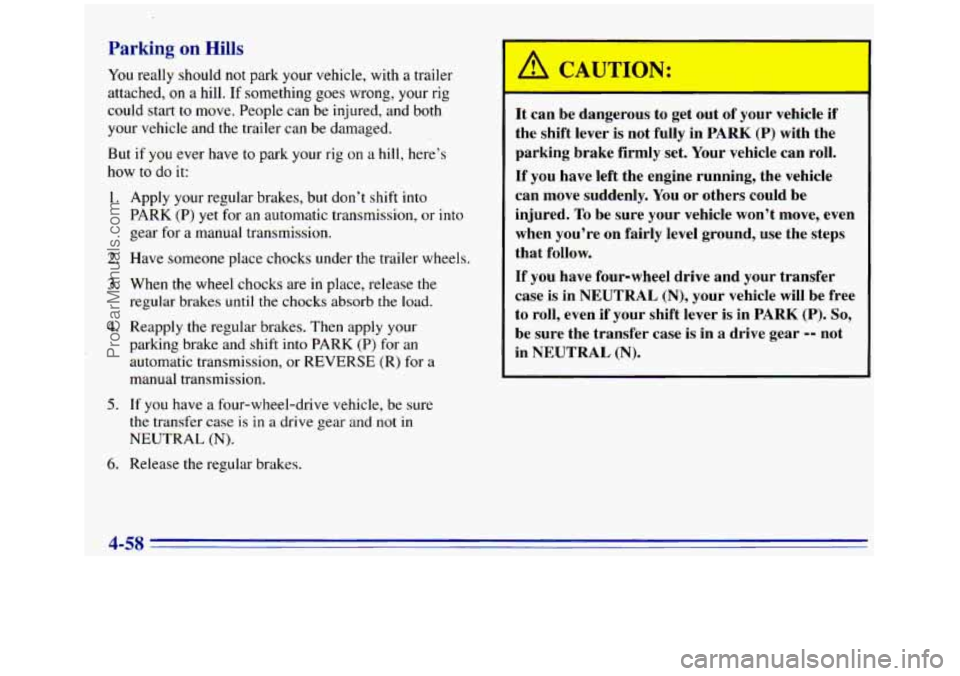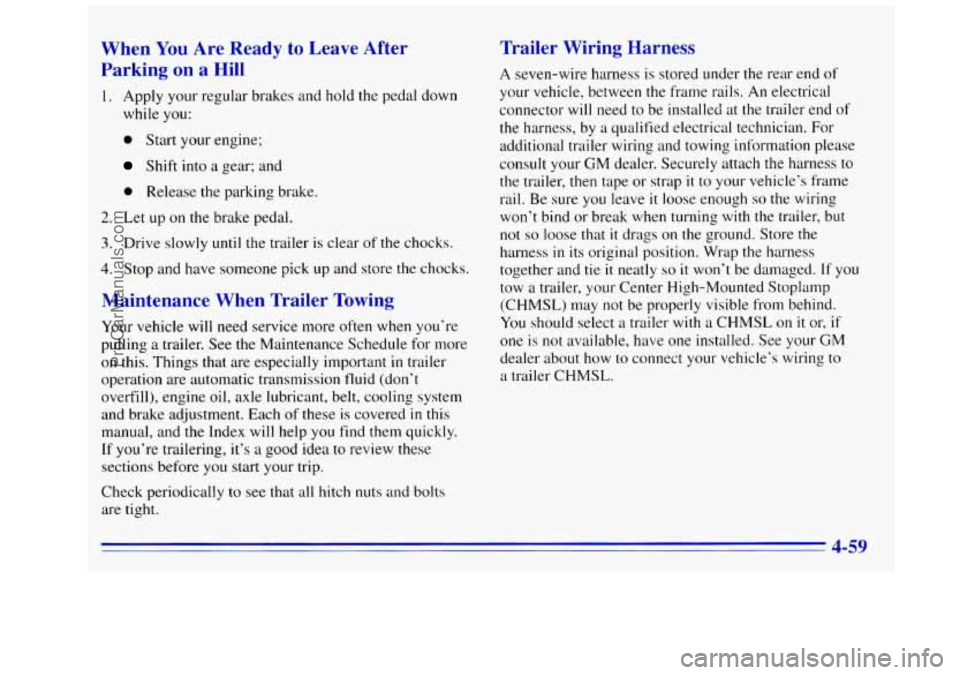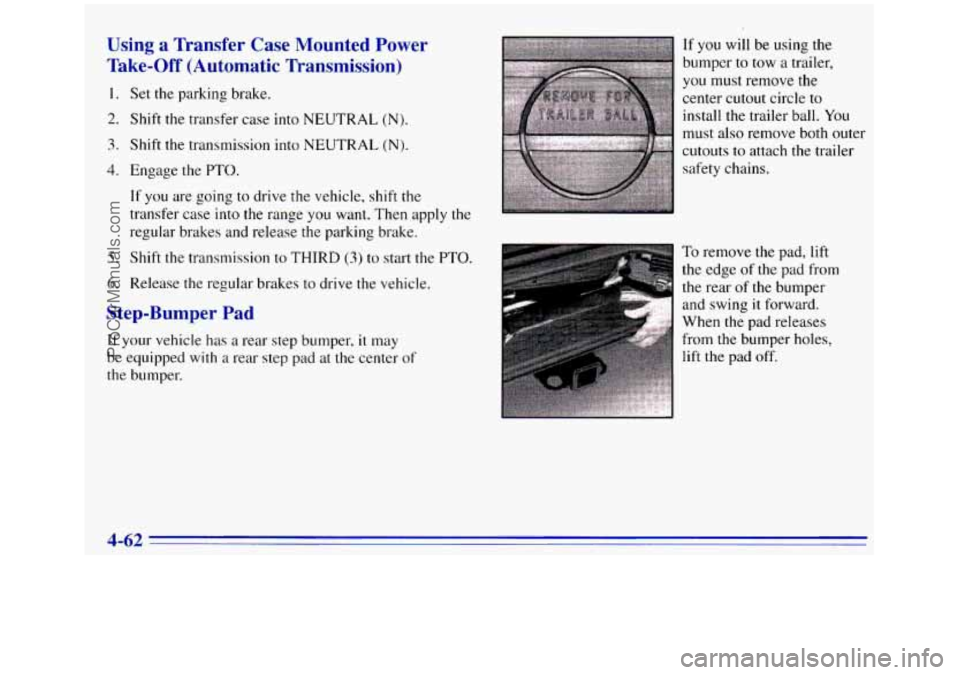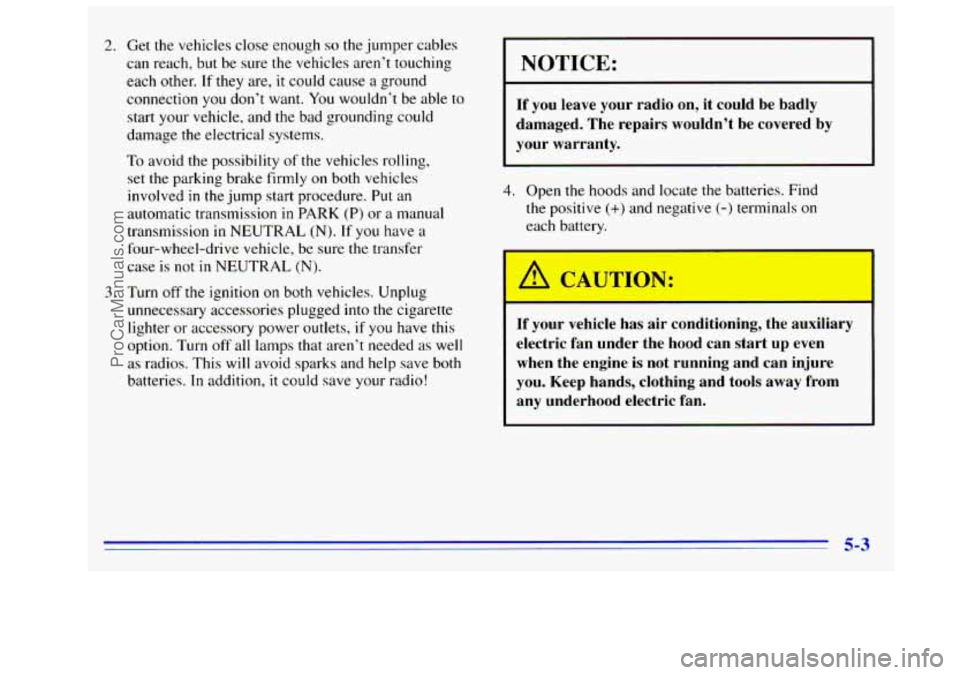1996 GMC SIERRA parking brake
[x] Cancel search: parking brakePage 211 of 404

Turn Signals When Towing a Trailer
The green arrows on your instrument panel will flash
whenever
you signal a turn or lane change. Properly
hooked up, the trailer lamps will also flash, telling other
drivers you’re about to turn, change lanes or stop.
When towing a trailer, the green arrows
on your
instrument panel will flash for turns even
if the bulbs on
the trailer are burned out. Thus, you may
think drivers
behind
you are seeing your signal when they are not. It’s
important to check occasionally to be sure the trailer
bulbs are
still working.
Driving On Grades
Reduce speed and shift to a lower gear be~m you start
down
a long or steep downgrade. If you don’t shift
down,
you might have to use your brakes so much that
they would get hot and
no longer work well.
On a long uphill grade,
shift down and reduce your
speed
to around 45 mph (70 km/h) to reduce the
possibility
of engine and transmission overheating.
If you have an automatic transmission, you should use
THIRD
(3) (or, as you need to, a lower gear) when
towing a trailer. Operating your vehicle in THIRD
(3)
when towing a trailer will minimize heat build-up and
extend
the life of your transmission
If
you have a manual transmission and you are towing a
trailer,
it’s better not to use FIFTH (5) gear. Just drive in
FOURTH (4) gear (or, as you need to, a lower gear).
When towing at high altitude on steep uphill grades,
consider the following: Engine coolant will boil at a
lower temperature than at normal altitudes. If
you turn
your engine off‘ immediately after towing at high altitude
on steep uphill grades, your vehicle may show signs
similar
to engine overheating. To avoid this, let the
engine
run while parked (preferably on level ground)
with the automatic transmission
in PARK (P) (or the
manual transmission out
of gear and the parking brake
applied) for a few minutes before turning
the engine off.
If you do get the overheat warning, see “Engine
Overheating’’
in the Index.
ProCarManuals.com
Page 212 of 404

Parking on Hills
You really should not park your vehicle, with a trailer
attached,
on a hill. If something goes wrong, your rig
could start
to move. People can be injured, and both
your vehicle and the trailer can be damaged.
But if
you ever have to park your rig on a hill, here’s
how to do it:
1.
2.
3.
4.
5.
6.
Apply your regular brakes, but don’t shift into
PARK (P) yet for an automatic transmission, or into
gear for
a manual transmission.
Have someone place chocks under the trailer wheels.
When
the wheel chocks are in place, release the
regular brakes until the chocks absorb the load.
Reapply the regular brakes. Then apply your
parking brake and shift
into PARK (P) for an
automatic transmission, or REVERSE
(R) for a
manual transmission.
If you have a four-wheel-drive vehicle, be sure
the transfer case
is in a drive gear and not in
NEUTRAL
(N).
Release the regular brakes. It can
be dangerous to get out of your vehicle if
the shift lever
is not fully in PARK (P) with the
parking brake firmly set. Your vehicle can roll.
If you have left the engine running, the vehicle
can move suddenly. You or others could be
injured.
To be sure your vehicle won’t move, even
when you’re on fairly level ground, use the steps
that follow.
If you have four-wheel drive and your transfer
case is in
NEUTRAL (N), your vehicle will be free
to roll, even if your shift lever is in
PARK (P). So,
be sure the transfer case is in a drive gear -- not
in
NEUTRAL (N).
ProCarManuals.com
Page 213 of 404

When You Are Ready to Leave After
Parking on a Hill
1. Apply your regular brakes and hold the pedal down
while
you:
0 Start your engine;
Shift into a gear; and
0 Release the parking brake.
2. Let up on the brake pedal.
3. Drive slowly until the trailer is clear of the chocks.
4. Stop and have someone pick up and store the chocks.
Maintenance When Trailer Towing
Your vehicle will need service more often when you’re
pulling
a trailer. See the Maintenance Schedule for more
on this. Things
that are especially important in trailer
operation are automatic transmission fluid (don’t
overfill), engine oil, axle lubricant, belt, cooling system
and brake adjustment. Each of these is covered
in this
manual, and the Index will help you find them quickly.
If you’re trailering, it’s a good idea
to review these
sections before you start your trip.
Check periodically
to see that all hitch nuts and bolts
are tight.
Trailer Wiring Harness
A seven-wire harness is stored under the rear end of
your vehicle. between the frame rails. An electrical
connector
will need to be installed at the trailer end of
the harness, by a qualified electrical technician. For
additional trailer wiring and towing information please
consult your
GM dealer. Securely attach the harness to
the trailer, then tape or strap it to your vehicle’s frame
rail.
Be sure you leave it loose enough so the wiring
won’t bind or break when turning with the trailer, but
not so loose that it drags on the ground. Store the
harness in its original position. Wrap the harness
together and tie
it neatly so it won’t be damaged. If you
tow a trailer, your Center High-Mounted Stoplamp
(CHMSL) may not be properly visible from behind.
You should select a trailer with
a CHMSL on it or, if
one is not available, have one installed. See your GM
dealer about how to connect your vehicle’s wiring to
a trailer CHMSL.
4-59
ProCarManuals.com
Page 214 of 404

-
DW * Winche- Power Take-Off (PTO)
IT you wish to use a power winch on your vehicle, only
use it when your vehicle
is stationary or anchored.
NOTICE:
Using a power winch with the transmission in
gear
may damage the transmission. When
operating
a power winch, always leave the
transmission in
NEUTRAL (N).
Use the regular brakes, set the parking brake, or block
the wheels to keep your vehicle from rolling.
NOTICE:
If you have a PTO that will exceed 35 hp installed
on your vehicle, it could damage the transfer
case or transmission. When having a
PTO
installed on your vehicle, make sure that it will
not exceed
35 hp.
Before using
a PTO, refer to the manufacturer’s or
installer’s instructions.
I NOTICE:
Using a PTO while operating in one place before
the vehicle has reached normal operating
temperature can damage the transfer case or
transmission.
If you will be using the PTO while
operating
in one place, drive and warm up the
vehicle before using the PTO.
ProCarManuals.com
Page 215 of 404

To engage a PTO:
1. Set the parking brake.
2. Shift the transmission into NEUTRAL (Nj.
3. Hold the clutch pedal down and engage the PTO.
NOTICE:
Using a PTO for more than four hours without
driving your vehicle can damage the transfer case
or transmission. If using a PTO for more than
four hours without driving your vehicle, drive
your vehicle for
a while to allow the transfer case
and transmission
to cool.
If you are going to drive the vehicle, shift the
transmission
into the gear you want. Then shift the
transfer case
into the range you want (if you have
four-wheel drive), apply the regular brakes and
release the parking brake.
4. Release the clutch (and the regular brakes) as you
normally would. When you release the clutch, the
PTO will start.
Using a Transfer Case Mounted Power
Take-Off
(Manual Transmission)
1. Set the parking brake,
2. Shift the transfer case into NEUTRAL (N).
3. Hold the clutch pedal down. If the vehicle will
remain
in the same place, shift the transmission into
the highest gear.
4. Engage the PTO.
If you are going to drive the vehicle, shift the
transmission into the gear
you want. Then shift the
transfer case
into the range you want, apply the
regular brakes and release the parking brake.
5. Release the clutch (and the regular brakes) as you
nor~nally would. When you release the clutch, the
PTO will start.
4-61
ProCarManuals.com
Page 216 of 404

Using a Transfer Case Mounted Power
Take-Off (Automatic Transmission)
1.
2.
3.
4.
5.
6.
Set the parking brake.
Shift the transfer case into NEUTRAL
(N).
Shift the transmission into NEUTRAL (N).
Engage the PTO.
If you are going to drive the vehicle, shift the
transfer case
into the range yo11 want. Then apply the
regular brakes and release the parking brake.
Shift the transmission to
THIRD (3) to start the PTO.
Release the regular brakes to drive the vehicle.
Step-Bumper Pad
If your vehicle has a rear step bumper, it may
be equipped with
a rear step pad at the center of
the bumper.
If you will be using the
bumper to
tow a trailer,
you must remove the
center cutout circle
to
install the trailer ball. You
must also remove both outer
cutouts to attach the trailer
safety chains.
To remove the pad, lift
the edge of
the pad from
the rear
of the bumper
and swing
it forward.
When
the pad releases
from
the bumper holes,
lift the pad off.
4-62
ProCarManuals.com
Page 219 of 404

2. Get the vehicles close enough so the jumper cables
can reach, but be sure the ve.hicles aren’t touching
each other.
If they are, it could cause a ground
connection you don’t want. You wouldn’t be able to
start
your vehicle, and the bad grounding could
damage the electrical systems.
To avoid the possibility
of the vehicles rolling,
set the parking brake firmly on both vehicles
involved
in the jump start procedure. Put an
automatic transmission
in PARK (P) or a manual
transmission
in NEUTRAL (N). If you have a
four-wheel-drive vehicle, be sure the transfer
case is not in NEUTRAL
(N).
3. Turn off the ignition on both vehicles. Unplug
unnecessary accessories plugged into the cigarette
lighter or accessory power outlets,
if you have this
option. Turn
off all lamps that aren’t needed as well
as radios. This will avoid sparks and help save both
batteries.
In addition, it could save your radio!
NOTICE:
I
~~~ ~
If you leave your radio on, it could be badly
damaged. The repairs wouldn’t be covered by
your warranty.
4. Open the hoods and locate the batteries. Find
the positive
(+) and negative (-) terminals 011
each battery.
A CAUTION:
If your vehicle has air conditioning, the auxiliary
electric fan under the hood can start up even
when the engine
is not running and can injure
you. Keep hands, clothing and tools
away from
any underhood electric fan.
5-3
ProCarManuals.com
Page 224 of 404

/A CAUTION:
To help avoid injury to you or others:
0
0
e
0
0
0
0
Never let passengers ride in a vehicle that is
being towed.
Never tow faster than safe
or posted speeds.
Never tow with damaged parts not
fully secured.
Never get under your vehicle after it has
been lifted by the tow truck.
Always use separate safety chains on each
side when towing a vehicle.
For pickups (except cab chassis models),
use T-hooks on front of vehicle, J-hooks
on rear.
For cab chassis models, use J-hooks on
front and rear of vehicle.
I A CAUTION:
A vehicle can fall from a car carrier if it isn’t
adequately secured. This can cause
a collision,
serious personal injury and vehicle damage. The
vehicle should be tightly secured with chains or
steel cables before it is transported.
Don’t use substitutes (ropes, leather straps,
canvas webbing, etc.) that can be cut by sharp
edges underneath the towed vehicle.
When your vehicle
is being towed, have the ignition
key in the OFF position. The steering wheel should be
clamped in a straight-ahead position,
with a clamping
device designed
for towing service. Do not use the
vehicle’s steering column lock for this. The transmission
and transfer case,
if you have one, should be in
NEUTRAL (N) and the parking brake released.
Don’t have your vehicle towed
on the drive wheels
unless
you must. If the vehicle must be towed on the
drive wheels, be sure to follow the speed and distance
restrictions later
in this section or your transmission will
be damaged.
If these limitations must be exceeded, then
the drive wheels have to be supported on
a dolly.
5-8
ProCarManuals.com